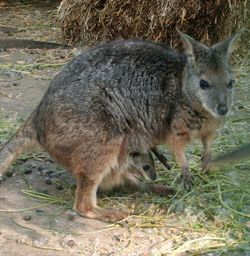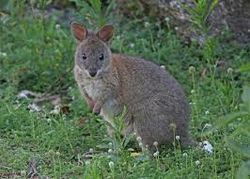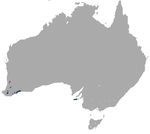Tammar wallaby
| Tammar wallaby |
|---|

|
| Scientific Classification |
|
| Scientific Name |
|
Macropus eugenii |
| This is about the actually size of a Tammar wallaby (there could be more growth). |
The Tammar Wallaby is a species of wallabies known as the scientific name Macropus eugenii. They are mainly native to the islands off the East Australian coast.[1]
Other names that the Tammar Wallaby is known by is the dama wallaby and the darma wallaby. They are known to be the smallest wallaby. They are a nocturnal animal, which means they are asleep all day and up and about all night.[2]
Body Design
The Tammar Wallaby is a small animal. It is actually known to be one of the smallest Marcropus of its species. The features on the wallaby's body are small, except for the ears and tail. They have long, big ears with a lengthy tails and thick base. The male weighs 20 pounds and are 23-27 inches long. The female weighs 15 pounds and grow to be 18 inches long. [3]The Tammar Wallaby is a short haired creature that has a light brown coat. Its limbs are not lengthy and its under belly coat is a pale brown.[4]Something that distinguishes the Tammar wallaby with other kangaroos is its skull. the main reason unto why they are so easy to set apart from others is because of its size. though size does have its ups and downs, there are some reals benefits to it. Because of it small size it is able to retain energy a lot faster than most wallabies. It also can also develop a sense of smell quicker than most.[5]
Life Cycle
When it comes to the reproduction of this animal, the process last 25-28 days long. Once the joey is born it must stay in the mothers pouch for 8-9 months until it is fully developed. The Tammar Wallaby never has more that on baby. They produce one baby each birth. The baby only weighs about a gram when it is first born. The female reaches full sexual maturity in 9 months and the male takes 2 years.[6]The life span of a Tammar wallaby is not one of the longest life spans compared to other kangaroos. The female wallaby lives for 14 years and the male lives for 11 years.[7]When a baby wallaby is first learning how to hop around and such, it will leave the mothers pouch. as soon as he or she senses danger though it will jump right back into the mothers pouch. The wallabies usually stay with their mother in the pouch for almost up to 2 years (24 months to be exact). When they are living on their own in the wild they can live up to 10 years, but when they are held in captivity such as a zoo, they are being well taken care of which affects they life spans and they end up living up to 14 years (no matter what the gender).[8]
Ecology
The Tammar Wallabies are located on the south Australian coast. they are herbivores so they mainly live in areas of great vegetation with many bushes and low trees.[9] The wallabies stay in groups to prevent lesser advantage of being taken by a predator. being in groups they spend most time foraging and interacting. Because the Tammar Wallaby is a nocturnal animal it usually stays under the shade during the day, then out in the fields at night.[10]They are pretty social animals that must be in groups to be able to socialize and mate, therefore, the must live in a very organized habitat or structure. The groups that they live together in are called mobs. They have all age types in these groups and they consist of about 50 wallabies. The males are the ones that are the head of the mobs to promote dominance.[11]
Endangerment
All Wallabies are endangered mainly because of the environment they live in. Because they are smaller creatures they a vulnerable and threatened. They are threatened by predators, drought, little food source, and destruction of their habitats.[12]
Though this species is endangered, it is classified as LC, which means least concerned it to the case of being endangered because it has a pretty stable population thanks to the animals immediate breeding. One of the reasons they believe that there has been less of a growth lately in their population is because of the shortage of wheat which is a ideal food source for the Tammar Wallaby, including grass. Because of this they have been searching out for a food replacemebnt to this by eating unknown plants.[13]At one point when their were plenty of wallabes, there began to be to many. so they decided to control their population with a poison called sodium fluoroacetate. they basically just used this to decrease the poppulation of them and it soon lead to the endangerment of them. [14]
Video
Here is a Tammar Wallaby in its natural habitat.
References
- ↑ ANIMILIA Tammar Wallaby. Web. last modified: 2018. (specify whether date of publication or last-modified or accessed - i.e. Published November 3, 2015.) author unknown
- ↑ ArticleTitle Publisher site name. Web. February 20th, 2018. (specify whether date of publication or last-modified or accessed - i.e. Published November 3, 2015.) author unknown
- ↑ Labiano-Abello, A. M. [1] Tammar Wallaby. Web. February 20th, 2018. (specify whether date of publication or last-modified or accessed - i.e. Published November 3, 2015.)
- ↑ World Association of Zoos and Aquariums Tammar Wallaby. Web. Month Day, Year. (specify whether date of publication or last-modified or accessed - i.e. Published November 3, 2015.) author unknown
- ↑ Authorlastname, Firstname. Tammar Wallaby Senses. Web. February 20th, 2018. (specify whether date of publication or last-modified or accessed - i.e. Published November 3, 2015.)
- ↑ Labiano-Abello, A. [2] Marcropus eugeniii Tammar Wallaby. Web. April 17, 2018. (specify whether date of publication or last-modified or accessed - i.e. Published November 3, 2015.)
- ↑ Breeding and development Tammar Wallaby. Web.February 20th, 2018. (specify whether date of publication or last-modified or accessed - i.e. Published November 3, 2015.) author unknown
- ↑ Wallaby and Wallaroo Care Development and Life Cyle of Wallabies. Web. last modified: July 2016. (specify whether date of publication or last-modified or accessed - i.e. Published November 3, 2015.) author unknown
- ↑ unknown. [3] Tammar Wallaby. Web.last modified:unknown. (specify whether date of publication or last-modified or accessed - i.e. Published November 3, 2015.)
- ↑ Tyndale-Biscoe, Hugh [4] Tammar Wallaby. Web. last modified: February 20th, 2018. (specify whether date of publication or last-modified or accessed - i.e. Published November 3, 2015.)
- ↑ . ANIMALIA Tammar Wallaby. Web. last modified: 2018. (specify whether date of publication or last-modified or accessed - i.e. Published November 3, 2015.) author uknown
- ↑ Authorlastname, Firstname. Are wallabies an endangered species? Wallabies are a collection of dozens of distinct species, some of which are endangered.. Web. February 27, 2016. (specify whether date of publication or last-modified or accessed - i.e. Published November 3, 2015.)
- ↑ Population dynamics and conservation Tammar Wallaby. Web. February 20th, 2018. (specify whether date of publication or last-modified or accessed - i.e. Published November 3, 2015.) author unknown
- ↑ Population dynamics and conservation Tammar Wallaby. Web. February 20th, 2018. (specify whether date of publication or last-modified or accessed - i.e. Published November 3, 2015.) author unknown


